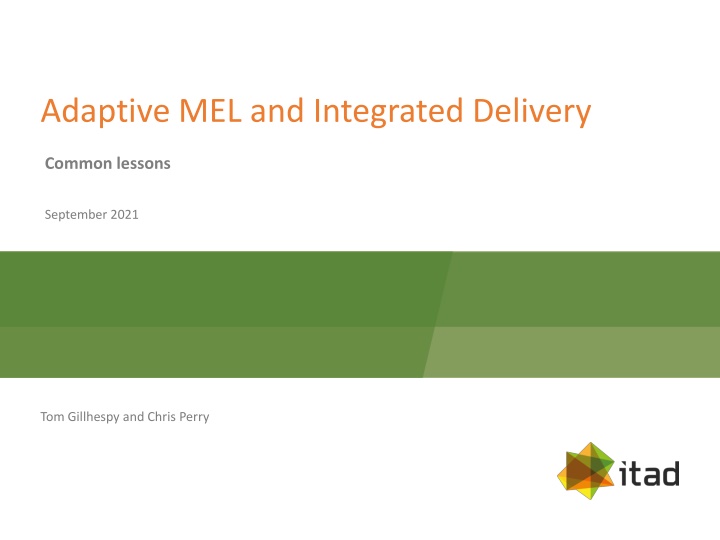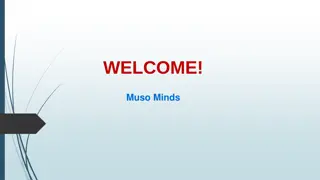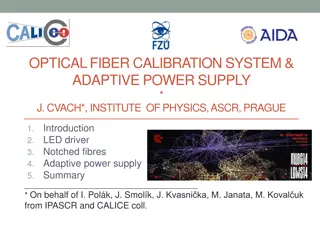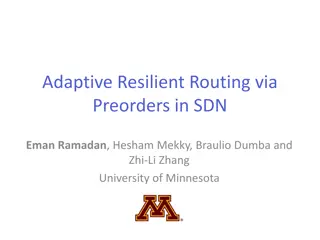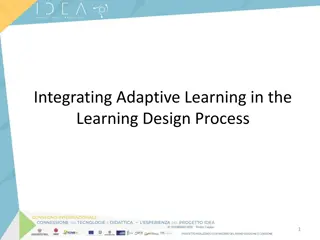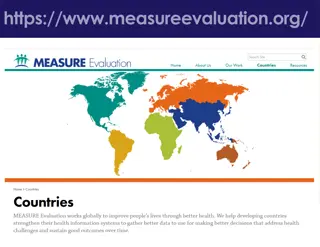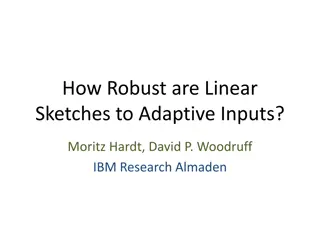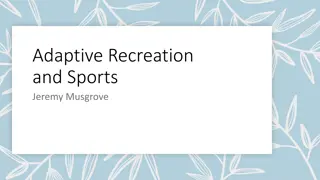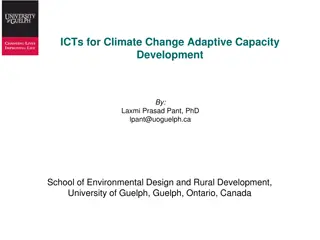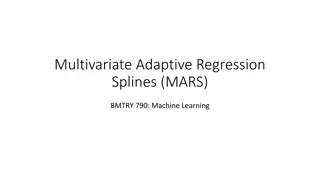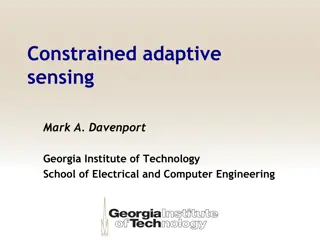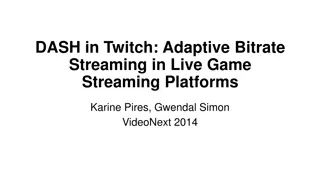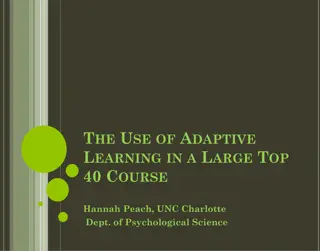Adaptive MEL and Integrated Delivery Common Lessons
The need for adaptive MEL in complex programming with multiple partners, driven by the increasing global challenges and the evolving UK positioning. Learn how adaptive MEL and integrated delivery are interconnected and essential in creating enabling environments for innovative approaches.
Download Presentation

Please find below an Image/Link to download the presentation.
The content on the website is provided AS IS for your information and personal use only. It may not be sold, licensed, or shared on other websites without obtaining consent from the author.If you encounter any issues during the download, it is possible that the publisher has removed the file from their server.
You are allowed to download the files provided on this website for personal or commercial use, subject to the condition that they are used lawfully. All files are the property of their respective owners.
The content on the website is provided AS IS for your information and personal use only. It may not be sold, licensed, or shared on other websites without obtaining consent from the author.
E N D
Presentation Transcript
Adaptive MEL and Integrated Delivery Common lessons September 2021 Tom Gillhespy and Chris Perry
Adaptive MEL: Needed now more than ever Why is adaptive MEL needed more than ever? FCO and DFID merger, repeated focus on integrated delivery = complex programming with multiple partners Increasing complexity of global challenges (climate and ecological crisis, pandemic, transnational threats, etc.) Plus new global positioning of UK Means new approaches and capabilities are needed that did not exist before and require experimentation Makes innovative approaches and adaptive MEL even more important
Introduction Draw on decade of adaptive MEL experience and more recent research on integrated delivery Adaptive MEL and integrated delivery go hand in hand and are increasingly needed Explore similarities and common challenges of adaptive MEL and integrated delivery Consider how MEL can help create the right enabling environments
Alignment between integrated delivery and adaptive programming Principles from Integrated Delivery Principles from Adaptive Programming Integrated delivery is where joint analysis and strategy development across departments is the norm, not the exception; where collaboration begins with a merging of knowledge and analytical capabilities. Begin with the problem rather than the solution to avoid bias of externally prescribed solutions with a strong focus on being politically smart. Integrated delivery is not only about UK cross- government working but includes key boundary partners beyond HMG, especially local partners. Problems should be locally defined and should ideally be defined by a coalition of actors. Integration is reliant on a culture of common purpose that is deeply rooted in the local context, and where institutional constraints are removed to allow innovation to flourish. The coalition of actors should have shared interest in addressing the problem with decision-making devolved to local implementing partners. Integration at a minimum produces an effect greater than the sum of its parts and, at its most aspirational, creates a whole new capability, or a catalytic effect. Adopt approaches like strategy testing and routine adaptation to allow intervention to evolve and change as required, potentially delivering in unexpected ways.
Some of the main challenges Overcoming these challenges Below we outline some common challenges to adaptive programming and integrated delivery: How MEL for adaptive programming can help overcome these challenges: Cultural change is required to embed new ways of working, needs senior-level buy-in and leadership to working differently MEL often seen as (at worst) a stick, (at best) a carrot but rarely as an enabler But MEL needs to be seen as an intentional enabler of the adaptive management that will be needed as integrated delivery increases demand Information sharing within HMG is often inward-facing, sharing with immediate team only Strategies are not context-specific enough; not rooted in local context Next we identify entry points for MEL in the project cycle accompanied by practical examples Reporting and governance mechanisms unclear, confusing who needs to provide what evidence, who needs to be involved in reflections, learning and decision making MEL considered as an add on rather than an integrated function from the design stage and throughout delivery
Entry points for MEL to enable adaptive programming 1. Context analysis and strategy development Locally-led contextual analysis and problem identification Learning from partnership-based approaches - supporting coalitions Develop and maintain a ToC which supports adaptability and learning Examples 1. Stability trackers that integrate analytical capabilities; bring together the right teams from the beginning, including local partners (peer-to-peer approach) 2. Cross HMG and partner ToC development encourages shared ownership of the problem and the objectives; shared strategy development 3. ToC is foundation for all MEL planning, identifying key evidence needed
Entry points for MEL to enable adaptive programming 2. Intervention design and management Collaboratively design interventions Use shorter (3-6 month) within year implementation cycles to help enable flexibility. Ensure learning and adaptation is intentionally built into designs and M&E plans Examples 1. Bedrock indicators, baskets of indicators, domains of change, key performance questions 2. TPM for CSSF Yemen was deliberately designed to inform adaptation and decision points 3. Integrating MEL for adaptive programming within the design of Development Engagements under Danida s new Kenya Country Programme
Entry points for MEL to enable adaptive programming 3. Evidence-informed analysis Use less formal intervention progress markers to monitor traction and direction of travel Use a mix of qualitative and quantitative methods to generate learning as well as evidence Integrate context monitoring within M&E plans (e.g. PEA or stakeholder mapping) Examples 1. Stability tracker that mixes political, economic, social data (quant and qual) across HMG teams and partners 2. Integrated delivery framework which monitors integration and collaboration 3. PAI tools that can help understand whether intervention is influencing PEA, and how PEA influences intervention 4. Sprint reports like Stories of Change and Outcome Case Stories centered on OH techniques
Entry points for MEL to enable adaptive programming 4. Learning and adaptation Undertake formal and inclusive reflection sessions at various levels to identify adaptations Delegate authority for making changes and streamline decision making between levels Document identified changes and their rationale, monitor their status, and track their effect Examples 1. Incentivize and embed learning and adaption by including learning-oriented indicators within results frameworks at different levels 2. Use a technique like Strategy Testing to drive as well as track an iterative process of learning and adaptation 3. Develop a clear framework which sets out the purpose and focus of learning and adaptation at different levels, including processes, periodicity and responsibilities
Summary Adaptive MEL is not new, but it is not widely taken up either Demands for integrated delivery increase the urgency and need for adaptive MEL become more widely understood and used There are common barriers that inhibit an enabling environment necessary for both mostly these are institutional and linked to difficulties of generating new ways of working If these can be overcome, then the potential for innovation, new capabilities and catalytic effect increase MEL can be an enabler if used in the right way at the right time
